NVIDIA GeForce FX 5800 Ultra 128MB
|

As usual, before we proceed to analysis of the new accelerator
we recommend that you read the analytic article scrutinizing the architecture
and specifications of the NVIDIA
GeForce FX (NV30)
CONTENTS
-
General
information
-
Peculiarities
of the NVIDIA GeForce FX 5800 Ultra 128MB video card
-
Test
system configuration and drivers' settings
-
Test
results: briefly on 2D
-
RightMark3D
synthetic tests: philosophy and tests description
-
Test
results: RightMark3D: Pixel Filling
-
Test
results:
RightMark3D: Geometry Processing Speed
-
Test
results:
RightMark3D: Hidden Surface Removal
-
Test
results:
RightMark3D: Pixel Shading
-
Test
results:
RightMark3D: Point Sprites
-
Test
results:
3DMark2001 SE synthetic tests
-
Additional
theoretical information and summary on the synthetic tests
-
Information
on anisotropic filtering and anti-aliasing
-
Architectural
features and prospects
-
Test
results: 3DMark2001 SE: Game1
-
Test
results:
3DMark2001 SE: Game2
-
Test
results:
3DMark2001 SE: Game3
-
Test
results:
3DMark2001 SE: Game4
-
Test
results:
3DMark03: Game1
-
Test
results:
3DMark03: Game2
-
Test
results:
3DMark03: Game3
-
Test
results:
3DMark03: Game4
-
Test
results:
Quake3 ARENA
-
Test
results:
Serious Sam: The Second Encounter
-
Test
results:
Return to Castle Wolfenstein
-
Test
results:
Code Creatures DEMO
-
Test
results:
Unreal Tournament 2003 DEMO
-
Test
results:
AquaMark
-
Test
results:
RightMark 3D
-
Test
results:
DOOM III Alpha version
-
3D
quality: Anisotropic filtering
-
3D
quality:
Anti-aliasing
-
3D
quality in general
-
Conclusion
3D graphics, 3DMark03 game tests
The long-awaited sequel of the 3DMark packet - 3DMark03 - was released
just shortly ago.




This packet will be separately scrutinized as soon as possible, and now
look at the current results:
3DMark03, 3DMARKS
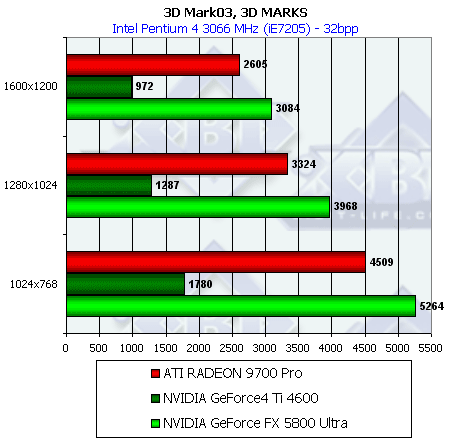

In general, the NV30 is a good boy. What helps it perform so well? We'll
find it out after testing with the 4 games included in this packet. At
the end we will make the conclusion and discuss what the 3DMark has turned
in.
3DMark03, Game1
Characteristics of the Wings of Fury test:


-
DirectX 7.0; approx. 32000 polygons on the scene, 16 MB memory used for
textures, 6 MB for buffers for vertices and 1 MB for indices.
-
All geometrical operations are based on Vertex Shaders 1.1 which can be
emulated via CPU (if there is no hardware support).
-
All planes have 4 texture layers, that is why the accelerators able to
process 4 textures in a pass will benefit.
-
Fire and tail effects are made with the point sprite techniques and others.
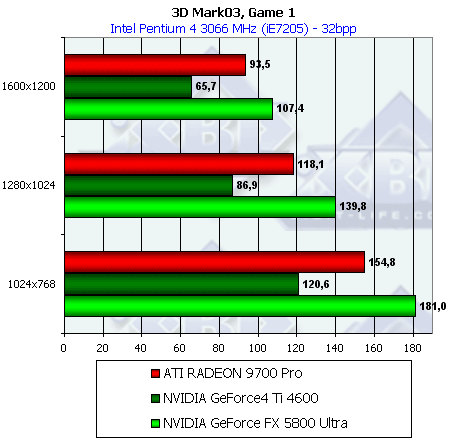

Well, the test is very simple for such cards.
3DMark03, Game2
Battle of Proxycon:


-
DirectX 8.1; Approx. 250 000 polygons on the scene with Pixel Shaders 1.1
(and 150 000 polygons on the scene with Shaders 1.4), 80 MB memory used
for textures, 6 MB for buffers for vertices and 1 MB for indices.
-
All geometrical operations are based on Vertex Shaders 1.1 which can be
emulated via CPU (if there is no hardware support).
-
All heroes are "dressed" with the vertex shaders as well.
-
Some light sources made dynamic shadows with a stencil buffer.
-
All pixel operations are carried out with the shaders 1.1, and if possible
with shaders 1.4.
-
Calculation of per-pixel lighting for haze effects and other components.
-
Accelerators supporting pixel shaders 1.1 use one pass for determining
Z buffer, then 3 passes for each light source. If an accelerator supports
shaders 1.4, it needs one pass for each light source.
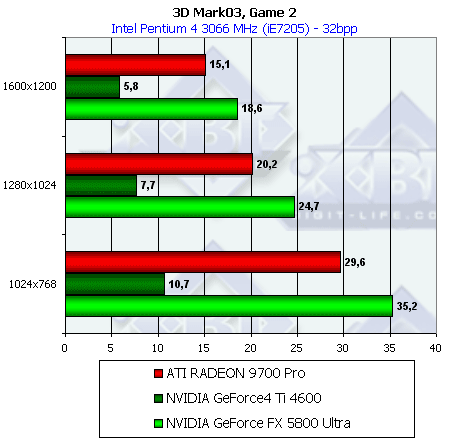

The situation is similar, and it is fatal for the GeForce4 Ti (the reasons
are clear - just look at the specs of this test).
3DMark03, Game3
Trolls' Lair:



-
DirectX 8.1; approx. 560 000 polygons on the scene with Pixel Shaders 1.1
(and 280 000 polygons on the scene with Shaders 1.4), 64 MB memory used
for textures, 19MB for buffers for vertices and 2 MB for indices.
-
All geometrical operations are based on Vertex Shaders 1.1 which can be
emulated via CPU (if there is no hardware support).
-
All heroes are "dressed" with the vertex shaders as well.
-
Some light sources made dynamic shadows with a stencil buffer.
-
All pixel operations are carried out with the shaders 1.1, and if possible
with shaders 1.4.
-
Calculation of per-pixel lighting for haze effects and other components.
-
Realism of the heroine's hair is achieved with physical models and anisotropic
lighting.
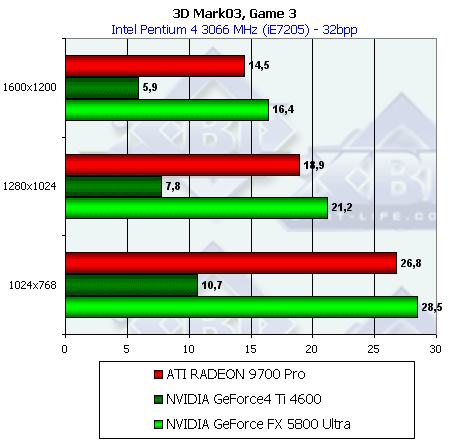

This test is more complicated, and the NV30 makes every effect to stay
ahead.
3DMark03, Game4
Mother Nature:





-
DirectX 9.0; approx. 780 000 polygons on the scene, 50 MB memory used for
textures, 54MB for buffers for vertices and 9 MB for indices.
-
Every leaf is separately animated with Vertex Shaders 2.0. The grass is
animated with vertex shaders 1.1.
-
The lake's surface is formed with pixel shaders 2.0.
-
The sky is made with pixel shaders 2.0, for sun glints the test uses the
extra precision of calculations realized in the DX9.
-
The earth surface is made with shaders 1.4.
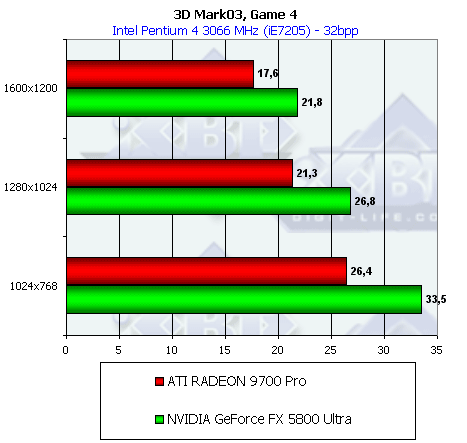

So, what's this? The pixel shaders 2.0 of the NV30 are not fast at all
but the NVIDIA's solution has a good advantage here. Let's analyze the
3DMark03 test itself.
The 3DMark03 is not a DirectX 9.0 or at least DirectX 8.1 packet in
the full sense of the word, because it contains tests for DirectX 7.0 and
some partial DX9 tests (Game 4 - shaders 2.0 are not used everywhere).
Of course, the packet is very heavy for the today's' accelrators, especially
of the previous generations. The developers as usual has made it with some
reserve for future. But does or will the 3DMark03 reflect the reality of
the game world? Will there be games with engines similar to the techniques
used in this packet? I doubt it. If the 3DMark2001 more or less reflected
some technologies used by the game developers (Max Payne is made on the
engine used for 3DMark2001), the 3DMark03 is entirely a thing in itself.
Well, we will certainly use this packet for comparative estimation of cards.
But I want to address the game developers once more time: will you please
make the benchmarks in games! All developers use the benchmark tools for
their internal purposes.
Another important issue is that three days ago when the drivers v42.68
weren't available yet, the NV30 failed in every test on the drivers 42.63
losing to the RADEON 9700 PRO. The programmers at NVIDIA proved that it's
not a problem to optimize a driver for a certain test: the driver 42.68
provided a good gain in the 3DMark03 (from 3500 to 5264), in games the
speed hasn't changed like in 3DMark2001. Tomorrow ATI will do the same
thing, then it will be NVIDIA's turn and so on. That is why think
well what the 3DMark actually reflects.
It's not self advertizing but we do have the RightMark 3D which is based
on the reference technologies from DirectX. We also offer the source codes
of the programs so that the experts can estimate it. For the moment it's
only synthetic tests, but games are right around the corner already.
[ Previous Part
(6) ]
[ Next Part (8)
]
Alexander Medvedev ( unclesam@ixbt.com)
Write a comment below. No registration needed!
|
|



























